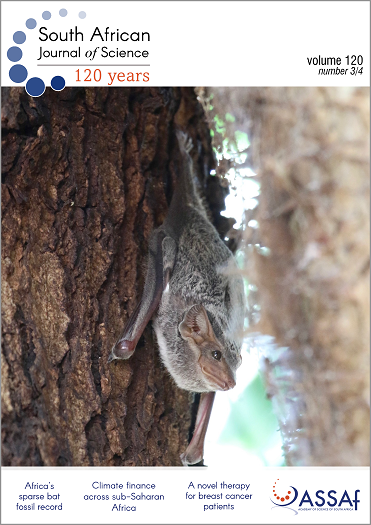Evaluation of pesticide residues and heavy metals in common food tubers from Nigeria
DOI:
https://doi.org/10.17159/sajs.2024/15969Keywords:
tubers, pesticide residue analysis, heavy metal analysis, gas chromatography–mass spectrometry, atomic absorption spectroscopy, maximum permissible limitAbstract
Pesticide residues and heavy metal content of cassava, yam, cocoyam, potato, water yam and carrot were evaluated by gas chromatography–mass spectrometry and atomic absorption spectroscopy. The detected pesticide residues in the samples were 2,4-dichlorophenoxyacetic acid, glyphosate, hexachlorobenzene (HCB), dichlorobiphenyl, aldrin, endosulfan, profenofos, g-chlordane, carbofuran, biphenyl, heptachlor, lindane and t-Nonachlor. The concentration of HCB ranged between 0.0799 ± 0.06 mg/kg and 0.1596 ± 0.00 mg/kg, which was greater than the permitted maximum limit of 0.5 mg/kg established by the US Environmental Protection Agency. The concentration of aldrin and profenofos detected was lower than the predetermined maximum allowed limits. Endosulfan concentrations in cocoyam (0.2500 mg/kg) and potato (0.3265 mg/kg) were higher than the limits allowed by the Canadian Department of Industrial Research. The heavy metals detected in these samples include cobalt, nickel, lead, manganese, chromium, arsenic and mercury in at least one of the samples evaluated. There was not much difference between the concentration of cobalt in yam (0.036 mg/kg) and the maximum allowed concentration (0.043 mg/kg). Lead was detected in potatoes and carrots but was below detectable concentration in cassava, yam, cocoyam and water yam. Similarly, cocoyam was found to have a significant mercury content (0.658 mg/kg), but mercury content was below detectable concentrations in cassava, yam and water yam.
Significance:
Heavy metal pollutants and pesticide residues can impair human health, and their presence in food can cause various illnesses and health issues. It is important to prevent exposure to these contaminants and ensure that food is safe by identifying and monitoring them. Farmers may provide consumers with more assurance that their products are safe by identifying and monitoring pesticide residues and heavy metal contamination in these food crops. Overall, it is crucial to find and monitor pesticide residues and heavy metal contamination in food to safeguard customer confidence, ensure legal compliance and preserve human health.
Downloads
Published
Issue
Section
License

All articles are published under a Creative Commons Attribution 4.0 International Licence
Copyright is retained by the authors. Readers are welcome to reproduce, share and adapt the content without permission provided the source is attributed.
Disclaimer: The publisher and editors accept no responsibility for statements made by the authors
How to Cite
- Abstract 425
- PDF 923
- EPUB 212
- XML 174
- Supplementary material 197












.png)